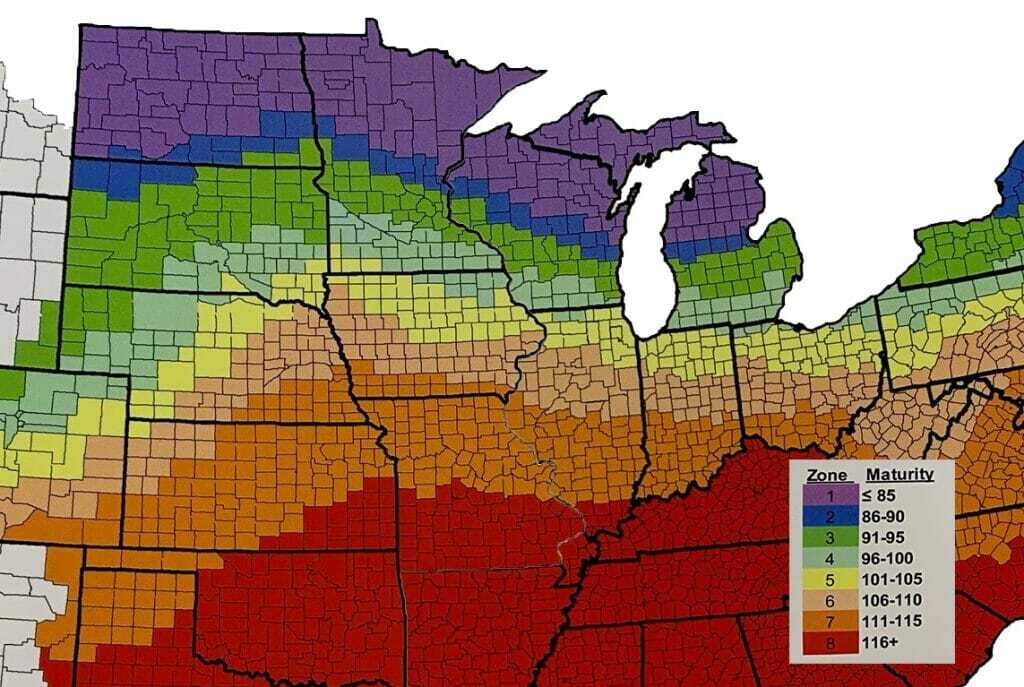Is it time? Tune in to hear Phil Long discuss the question of the season. Is it time to switch corn maturities? #AskTheAgronomist
-
Latham Hi‑Tech Seeds
#AskTheAgronomist: 2019 Planting Season Continues to be Delayed
 Tune in this morning as Phil Long discusses different options for farmers to consider as we wait to get back in the field. #AskTheAgronomist
Tune in this morning as Phil Long discusses different options for farmers to consider as we wait to get back in the field. #AskTheAgronomist -
Latham Hi‑Tech Seeds
#AskTheAgronomist: Crusting Soils

How does crusting and rolling soybeans go hand in hand this season? Phil Long talks about these two topics in reference to this year’s growing season.
-
Latham Hi‑Tech Seeds
#AskTheAgronomist: Imbibitional Chilling or Chilling Injury?

Will your planted fields be affected by imbibitional chilling? Tune in the hear symptoms of the chilling effect.
-
Latham Hi‑Tech Seeds
Key Dates for Switching Maturities
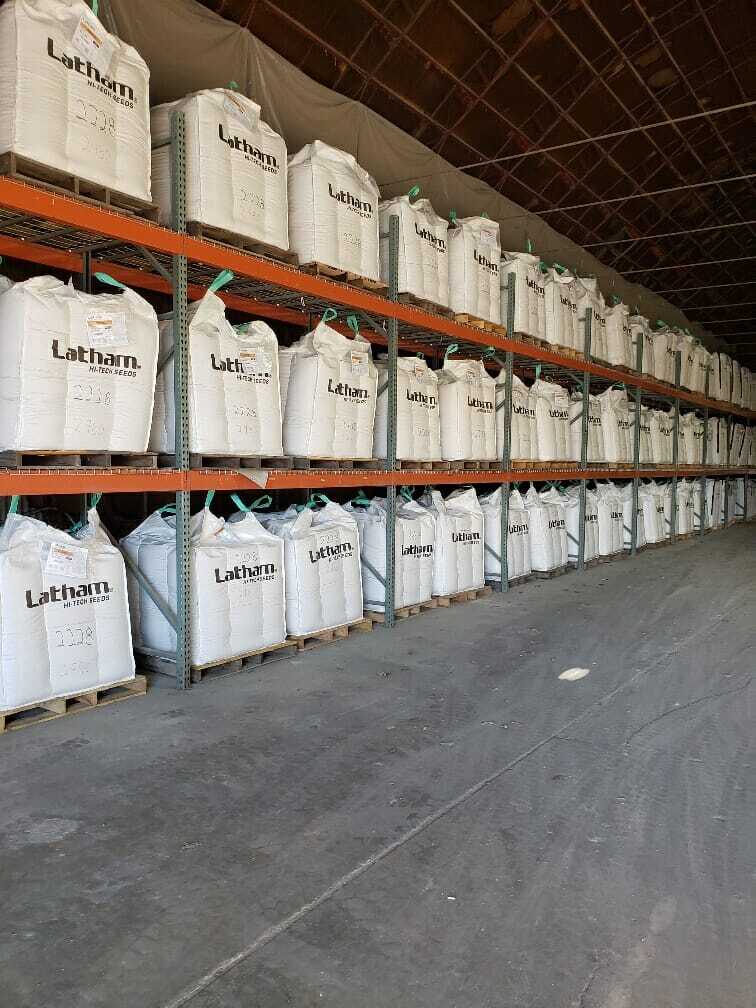
Each day we turn the calendar, I receive more calls from Latham® dealers and farmers asking whether they should change maturities. Keep in mind, the object is to achieve maximum yield potential for this crop. When you switch maturities, you forfeit maximum potential and have essentially decided to lower your yield expectations!
Based on my experiences over the past 40 years – as well as research findings from many Midwest land grant institutions – I can tell you with confidence that full-season hybrids and varieties outperform early maturing hybrids and varieties. Most people jump the gun and make the switch way too soon. Corn planted in mid-June can make decent yields, and there’s no need to switch from corn to soybeans until after that.
There becomes a point in time where the advantages of planting a full-season hybrid diminishes to the point where shifting to a shorter-season hybrid or variety will generally result in drier corn and higher yields come fall. Below is a summary of factors to consider when deciding whether to switch corn or soybean maturities.
CORN
I’ll use northern Iowa and southern Minnesota as an example. If your maturity range is 98- to 109-days (which is what I use for the Latham Research Farm), then you should generally not deviate from those maturities until at least May 25. If all you have left to plant is your 98-day hybrids, then you can safely extend your planting window to about June 7-10. On the other hand, if you only have your 109-day hybrids left to plant, you’ll probably be better off switching to 95- or 99-day products.
That brings us to the next subject… if you must switch, how early of a hybrid is needed? You don’t need to take it to extreme and switch from 109 RM to an 85-day hybrid or something equally silly! Research has proven that it pays to stay closer to your “normal” maturity. Switch to hybrids that are about 5 to 7 relative maturity units earlier than full season for the region. Yields in this scenario will be greatly improved if northern Iowa and southern Minnesota farmers (from the example above) move toward a 92- to 95-day hybrid that is more closely adapted to the area.
The decision to switch maturity with delayed corn planting is difficult because of so many variables including: available GDUs, first frost date and fall drying conditions. With this in mind, here are some general guidelines for Iowa farmers:
Location
within IowaFull Season RM Switch to
on May 25Switch to
on June 10South of U.S. 92 114-117 108-111 105-109 Central 108-115 104-110 100-106 North of U.S. 20 100-109 96-105 94-100 For your convenience, below are few links to related articles: Adjust this information depending on where you farm, but make your decision is based on sound research and not “coffee shop facts.” Just because your neighbor is switching doesn’t mean it’s the best decision. Conduct a little research of your own before deciding what might be best for your operation.
- Soybean Planting Decision Tool by Iowa State University Extension
- Late Corn Planting Options by Iowa State University Extension
- Corn Planting Guide by South Dakota State Extension
- Considerations for Late Planted Corn by North Dakota State University
- Soybean Planting Date and Maturity Considerations by University of Wisconsin-Madison Extension
- Considerations for Late-Planted Corn in Minnesota by University of Minnesota Extension
SOYBEANS
There is absolutely no reason to start switching soybean maturities until at least mid-June. I use June 20 as our cutoff here in North Central Iowa, but again, it depends on what you were planning to plant in the first place. In this area, bean maturities range from 1.8 to 2.7. L 2482 R2’s are still good to plant in this region until mid-June as we’ve done it before with great results.
Soybeans have even more resiliency when it comes to maturity stretch. Because soybeans are more “photo period” sensitive, they actually adjust based on the length of the nighttime. A planting date of June 20 in southern Wisconsin and June 15 in northern Wisconsin, using early maturing varieties, was considered to be the latest practical date by the University of Wisconsin. Soybeans can be planted in our area as late as the Fourth of July with decent yield results as long as we don’t go into a dry period.
 The 2019 planting season will certainly test our patience! It’s tough to turn pages off the calendar without putting any seed in the ground, but it’s better to wait a few more days than to mud seed into the ground. Experts warn that compaction and/or inadequate seed-to-soil contact from planting in wet conditions cause yield reductions for soybean farmers. During a wet year, it’s even more important for soybean growers to pay close attention to machinery. Avoiding soil compaction and obtaining good soil closure over seeds will help increase yields. For more soybean planting tips to boost yields, click here.
The 2019 planting season will certainly test our patience! It’s tough to turn pages off the calendar without putting any seed in the ground, but it’s better to wait a few more days than to mud seed into the ground. Experts warn that compaction and/or inadequate seed-to-soil contact from planting in wet conditions cause yield reductions for soybean farmers. During a wet year, it’s even more important for soybean growers to pay close attention to machinery. Avoiding soil compaction and obtaining good soil closure over seeds will help increase yields. For more soybean planting tips to boost yields, click here. -
Latham Hi‑Tech Seeds
Planting Tips with Snow in the Forecast

Join us this morning on #AskTheAgronomist as we discuss pertinent planting tips with the recent addition of snow in the forecast. #LathamSeeds
-
Latham Hi‑Tech Seeds
Fall Frost Damage in Corn and Soybeans
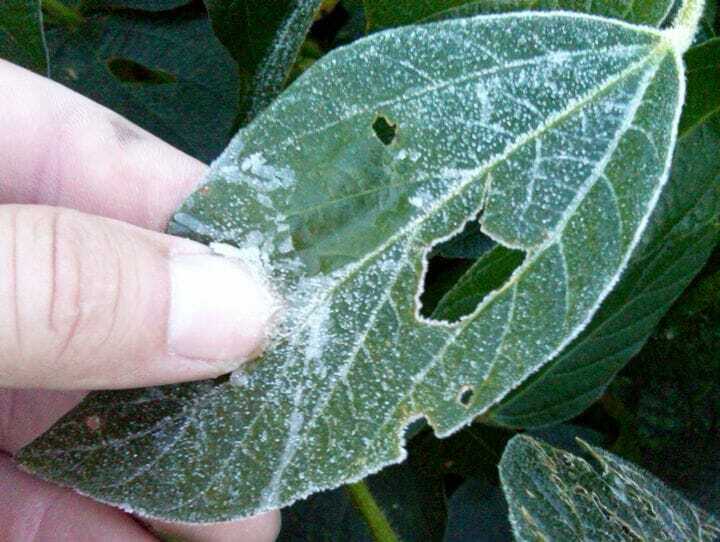
Frost damage occurs in corn and soybeans when plants are exposed to freezing or below-freezing temperatures. Damage can occur to the plants above and below the soil when temperatures range from 28 to 32°F and colder. Corn and soybean plants exposed to air temperatures below 28°F are often lethal and prevent plants from undergoing full recovery from injuries. The key in assessing frost damage is waiting five days to allow for any potential growth recovery or rehabilitation to occur.
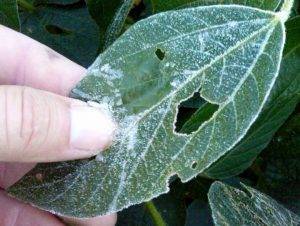
Credit: Michigan State University Fall Frost in Soybeans
Once soybeans begin maturity and already have developed pods, they are most often immune from frost injury. Soybeans placed in narrow rows can have more protection from freezing air temperatures in being covered by leaf canopies. Pods growing on the lower portion of the plant are less vulnerable to frost damage than those on the top part of the canopy. Injured soybeans exhibit elongated pods that shrink to smaller than normal sizes upon drying. Most yield loss occurs during the full seed maturity stage.
Soybeans damaged by frost should be dried at a temperature no higher than 130°F and may have lower oil content. Both frost damaged corn and soybeans may also have delayed dry down.
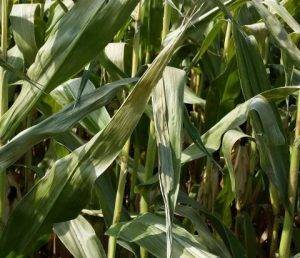
Credit: University of Minnesota Fall Frost in Corn
Frost-damaged corn can exhibit softened kernels prone to breakage and should be dried at temperatures below 160°F and be stored at a moisture level no higher than 14%. The storage life for frost-damaged corn will be cut in half and damaged corn should be handled separately from uninjured corn.
-
Latham Hi‑Tech Seeds
Rootless Corn Syndrome
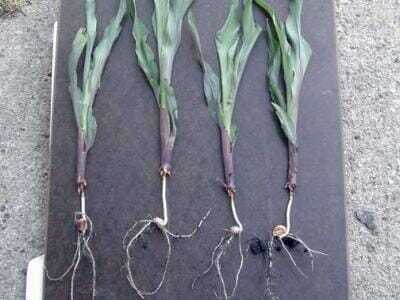

Credit: Iowa State University Rootless corn syndrome is a disorder, often a result of hot and dry soil surfaces and planting into dry soil. With rootless corn syndrome, the nodal roots will fail to attach to the soil. Nodal roots are essential conduits for transporting water and nutrients to corn plants. Their absence is highly consequential for the quality of stand and overall yield outcomes.
Dry soils warm more rapidly than moist soils, and combined with conventional tilling, corn plants can become susceptible to failed nodal root development. Heavy rainfall and planting when the soil is too wet can compact the soil, preventing nodal roots from extending downward.
The erosive effects of rainfall and wind combined with shallow planting depth are the primary drivers of rootless corn syndrome. In addition to weather-related causes, when corn is planted at a depth less than 1 inch below the surface, nodal root development can take place at a depth shallower than what is needed for having access to moist soil. Nodal roots should form between 1 to 1.5 inches below the surface.
What to Look for
Nodal roots first appear around the V1 and V2 stage. Rootless corn occurs in plants with poorly developed root systems and is usually observed in plants from about V3 to V8. When rootless corn syndrome is suspected, look for signs of lodged and collapsed corn plants. Corn plants may still be standing but later on they will lose vigor and fall over. Test plants in the area of concern by tugging on them to determine whether nodal roots are established and growing down.
Preventative Action
Rootless corn can largely be prevented by ensuring that seeds are planted at least 1.5 to 2 inches below the soil surface. For corn plants whose nodal roots fail to grow, the prospects for survival are bleak. Corn nutrient and water uptake hinges on having a developed nodal root system. For plants that do survive, poor stands and low vigor will be exhibited.
Moving soil to cover roots may allow them to recover – but if an operation is following a no-till plan, this may not be viable. Further, row cultivation for bringing soil around nodal roots will be ineffective if the soil below the surface lacks moisture for supporting recovery. Adequate rainfall and the absence of drought conditions will support optimal nodal root development and prevent rootless corn syndrome.
-
Latham Hi‑Tech Seeds
Protect Soybeans from Cold Temperatures
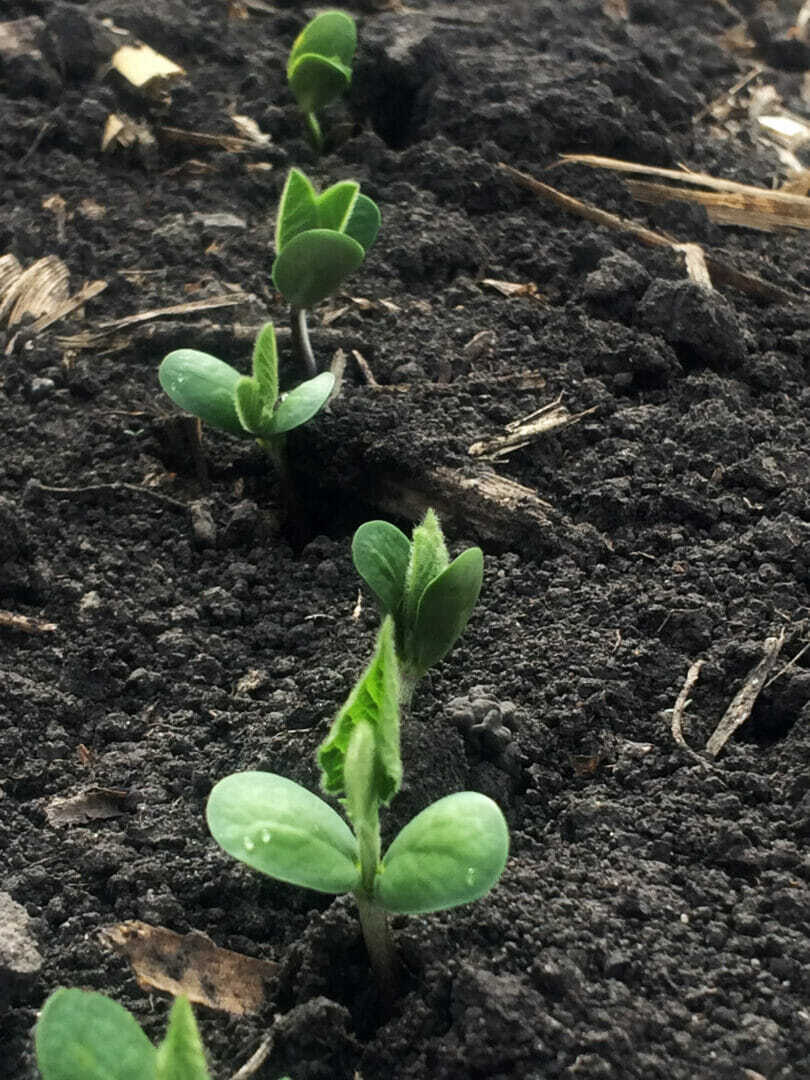
 Many of our minds are already on the upcoming planting season. This week someone posed the following question, “How hard of a frost can soybeans withstand?”
Many of our minds are already on the upcoming planting season. This week someone posed the following question, “How hard of a frost can soybeans withstand?”It’s a great question, so I wanted to address the topic of early planting a bit, well, “earlier” than usual!
The first thing to keep in mind is that cold temperatures at or before planting can negatively affect the growing point of the plant. For corn, that growing point stays under the soil surface until the V5-V6 stage, helping protect the plant to a certain degree from colder weather spells for several weeks. For soybeans, however, the growing point comes out of the ground at emergence. Therefore, a soybean seedling is immediately vulnerable to cold weather.
Using a fungicide seed treatment will help protect young soybeans from seedling diseases at this early stage, but they are not designed to protect against cold temperatures. Soybeans typically require over 100 growing degree units (GDU’s) to accumulate before emergence, which is similar to corn that requires about 125 GDU’s. Abiding by the minimum soil temperature of 50 degrees Fahrenheit will keep you away from poor emergence and the seedling disease risk associated with soil temps below 50 degrees. That’s why I suggest watching the weather forecasts before you plant soybean seed, and do your best to ensure hard frosts (which take place at 28 degrees Fahrenheit) are no longer possible.
Remember, when soybeans emerge, they have a growing point at the base of each cotyledon and at the main shoot. The main shoot is the small leaves in-between the cotyledons. If you notice brown on the stem below the cotyledons, the plant will not recover. Early planting is proven to provide higher yields, but it is is fine balance between the two, so watch weather forecasts and soil temperatures so you can find the balance on your own farm.
Additional tips to keep in mind before planting:
- Grab a clump of soil and watch how easily it crumbles. If it stays in a ball, conditions are NOT right for planting. If it crumbles easily, the soil is fit for planting.
- Make sure your planting date is covered in your farm insurance policy – this includes your “do not plant before” dates. If you plant outside those dates, your insurance could be jeopardized.
-
Latham Hi‑Tech Seeds
Spring Frost Damage in Corn and Soybeans

Frost damage occurs in corn and soybeans when plants are exposed to freezing or below-freezing temperatures. Damage can occur to the plants above and below the soil when temperatures range from 28 to 32°F and colder. Corn and soybean plants exposed to air temperatures below 28°F are often lethal and prevent plants from undergoing full recovery from injuries. The key in assessing frost damage is waiting five days to allow for any potential growth recovery or rehabilitation to occur.
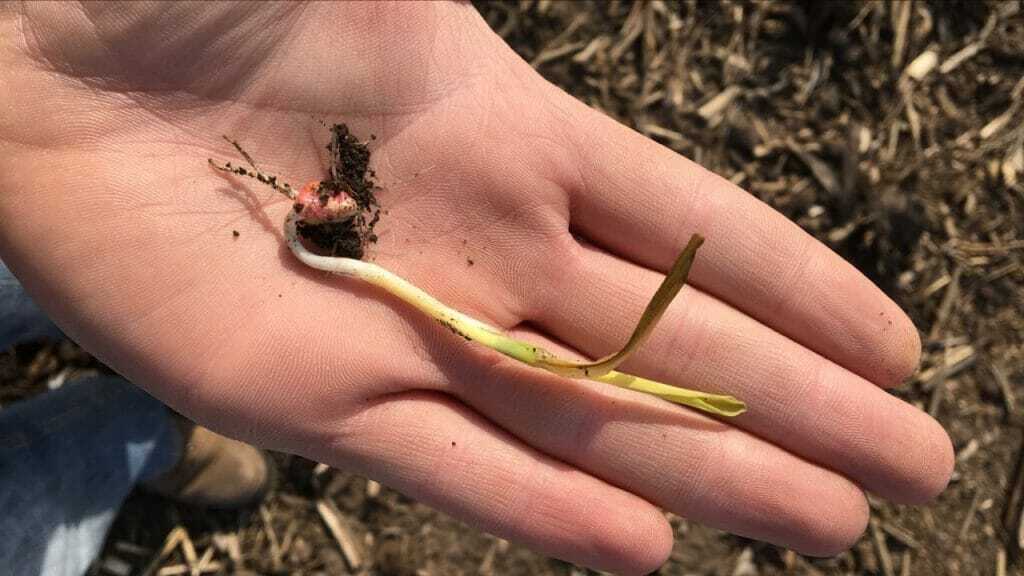 Spring Frost in Soybeans
Spring Frost in Soybeans If frost damage occurs below the soybeans’ cotyledons – the first leaves that emerge above ground – the plant will mostly likely fail to recover. Wilted and dried leaves will often remain on the plant after a frost event. In recovering soybeans, new leaves will emerge at the site of cotyledons – the first pair of embryonic leaves that appear above ground. If auxiliary buds growing at the juncture of the plant’s stem and cotyledons are not frozen, the plant is on track for recovery.
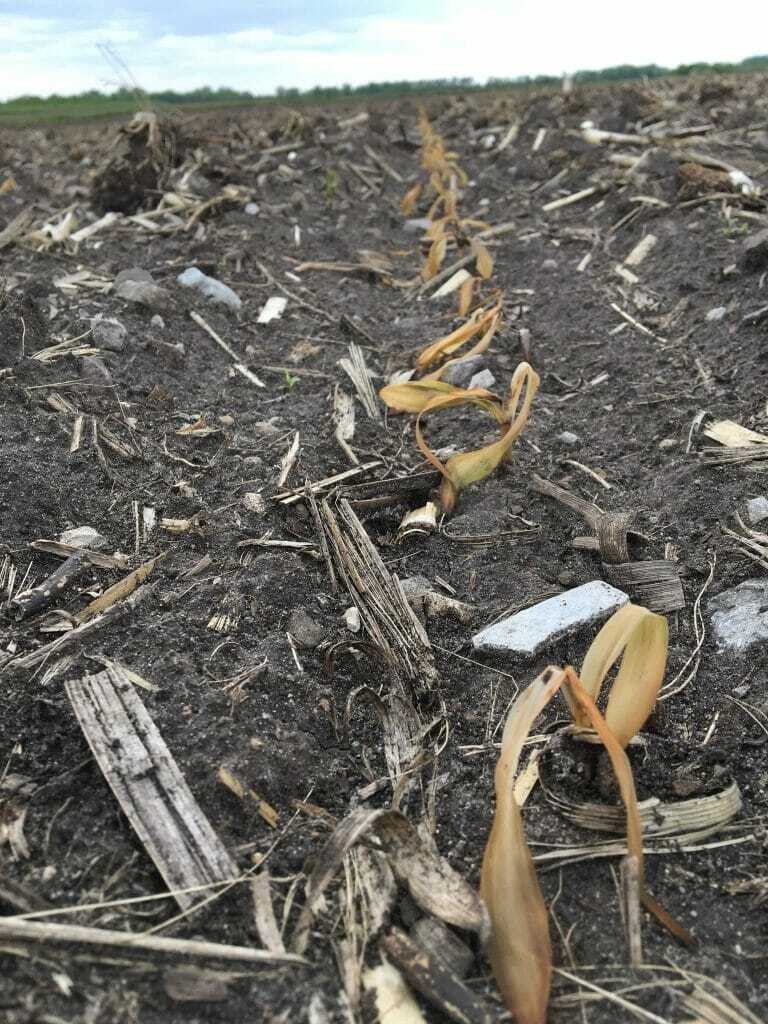 Spring Frost in Corn
Spring Frost in Corn Since corn plants are protected by soil for a longer period of time relative to soybeans, they are less susceptible to lethal frost injury. However, temperatures below 28°F can cause damage below the soil and compromise growth, leading to poor stands. Once the growing point is above ground, corn plants exposed to 32°F for a few hours and 28°F for a few minutes can be lethal. After an initial frost, continued cool temperatures can decrease yield due to the onset of stalk rot diseases.
If frost occurs before V6, yield loss is minimal. In recovering corn plants, you should see new leaf growth emerging from whorls. Yellow-colored tissue that exists above the growing point is a sign of regeneration.


